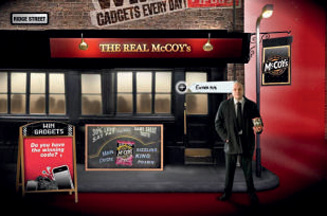Now, there are two things I find arresting about that advert. It is one of the first efforts by mainstream television to satirise the East End hipster, a character that has already been parodied to within an inch of its miserable, drainpipe-clad life on the internet. But it is also emblematic of what appears to be a new advertising demographic: Real Man.
Unless it was a household cleaning product or a fat-free mid-morning snack, virtually all advertising was directed at men; who, after all, had the jobs and the money. Now, we are a marketing pie-chart segment all of our own, to be targeted and baited and segregated into ‘real’ and ‘unreal’ strata, like fur coats.
So let us examine what exactly constitutes Real Man in Britain in 2012.
Clearly, he plays with tanks. He eats McCoy’s (“man crisps”), and bacon sandwiches with HP Sauce, (“makes a sandwich, a man-wich”), and Yorkies (“not for girls”), and Ginsters pasties, which last year launched a campaign that featured a succession of men begging their girlfriends to let them eat their sweaty little grease-parcels at the dinner table.
Given his dietary intake, then, it is fair to assume that Real Man is probably obese, too broad of girth even to fit in a tank, let alone play with one. In fact, Real Man is too laden by snack food to be able to do very much at all except sit on his sofa watching ITV4 (“real men’s TV”) and bet on the football.
For football betting is one of advertising’s major growth areas. The real deluge began during Euro 2012, when betting companies took advantage of a new legislative loophole allowing them to screen adverts before the watershed, as long as they were tied to a sporting event.
Hence the exponential rise in ‘in-play’ betting adverts, and a similar increase in Ray Winstone’s incidental earnings.
Winstone, who advertises Bet365, is an ideal totem for the nation’s sofa-bound, penury-stricken diabetes victims. Real Man lionises him for his toughness, even though he is merely an actor who went to acting school.
Other adverts play on our manhood in different ways. Ladbrokes, for example, features Chris Kamara being interrupted whilst engaged in a variety of ‘metrosexual’ pursuits – advertising shampoo, knitting, playing chess.
The firm sponsors ITV4’s coverage of the Europa League, creating what I like to call a virtuous circle of real manliness.
So much window dressing, you may contend. Yet even for those of us who fast-forward straight through the adverts, who have the same aversion to gambling that Nani has to crossing first time, these are valuable artefacts.
For they give us some idea of how football fans – you and me and all the people we know – are regarded by others.
This, football, is how non-football sees us: impetuous, irrational, easily led and just as easily misled, troglodytes with chips on our shoulders and chips in the oven.
When a group of Tottenham fans were attacked in a Rome bar last week, many news outlets reported it as a “brawl” or a “fight”, rather than what it was: a brutal, murderous ambush. From artless advertisers to avaricious administrators to condescending club owners, the football fan is disdained.
The scandal, of course, is how little this popular concept is rooted in reality. For one thing, women now make up around a quarter of fans.
A good deal has changed over the last few decades – the safety of grounds, the colour of Cardiff City’s shirts, the length of Chris Waddle’s mullet. But in terms of how football fans are perceived, we may as well still be in the 1980s, with Margaret Thatcher in Downing Street.
She was a woman, remember. And she loved playing with tanks.


